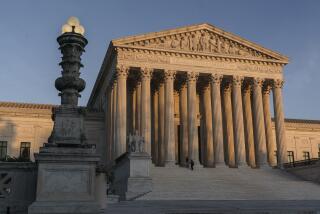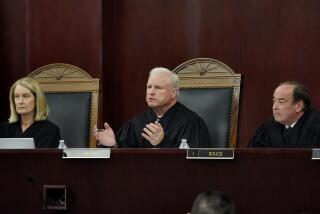Bushâs Judicial Nominees Go 28 for 80 in the Senate
WASHINGTON â In early May, President Bush proudly introduced his first judicial nominees in a White House ceremony and said all 11 of them had âsterling credentialsâ to sit on the U.S. Court of Appeals.
Most already were judges on lower courts; four others were prominent lawyers or law professors who had clerked at the U.S. Supreme Court.
But as the year ends, only three of these nominees have won confirmation in the Democrat-controlled Senate. In all, the White House has made 80 judicial nominations, but has won confirmation on only 28 new judges.
So far, Bush is finding the process of appointing federal judges much as President Clinton found it: slow, frustrating and uncertain.
âThe Republicans played hardball with Clintonâs nominees. Now the Democrats are playing hardball with Bushâs,â said Sheldon Goldman, a political scientist at the University of Massachusetts in Amherst. âThe Republicans rewrote the rules when Clinton was in office, and the Democrats are unwilling to turn the other cheek now.â
Goldman says the process has broken down. âThe partisanship has gotten out of hand. The âadvise and consentâ process has turned into âobstruct and delay.â â
Compared with his recent predecessors, Bush had the typical first year in naming judges.
A new team of lawyers at the Justice Department and the White House counselâs office usually have several months to crank out the first nominations. And the Senate Judiciary Committee takes a few months more to complete a basic investigation of each nominee. Only then is a hearing scheduled.
In 1989, then-President Bush had only 15 new judges confirmed, while Clinton had 27 confirmed in his first year as president.
But Bushâs legal team was determined to get off to a fast start. They also focused their attention on the appeals courts, which oversee the trial judges and set the law in their regions.
Their first nominees included an all-star team of relatively young conservatives. University of Utah law professor Michael McConnell, 45, is a recognized authority on the Constitutionâs religion clauses. He believes the Supreme Court has gone too far in barring public aid to parochial schools. Washington lawyer John G. Roberts, 46, and Ohio attorney Jeffrey Sutton, 40, have proved themselves as highly effective advocates before the Supreme Court.
But Suttonâs court victories have won him no friends among liberals. He represented Alabama in two statesâ rights cases. The first shielded the states from being sued by disabled workers who are discriminated against. The second barred suits against states under the Civil Rights Act of 1964 for policies that have a discriminatory effect on minorities. Sutton also represented the tobacco industry in a successful free-speech attack on state laws that prohibited posted cigarette ads near schools or playgrounds.
In midyear, the Democrats retook control of the Senate, and the Judiciary Committee, now led by Sen. Patrick J. Leahy (D-Vt.), has taken no action on the nominations of McConnell, Roberts, Sutton and five other Bush nominees. Also in limbo is Los Angeles County Superior Judge Carolyn Kuhl, a Reagan administration veteran who was nominated in June to the U.S. 9th Circuit Court of Appeals.
In a nod toward bipartisanship, Bush nominated two African American Democrats in his first batch of judges. They are Judge Roger Gregory, whom Clinton had named to a temporary slot on the U.S. 4th Circuit Court in Richmond, Va., and Judge Barrington Parker Jr., whom Clinton had named as a trial judge. Bush chose Parker for the 2nd Circuit Court in New York.
Leahyâs committee approved them quickly. It did the same with Edith Brown Clement, a Louisiana judge who moved up to the U.S. 5th Circuit Court in New Orleans.
But White House lawyers are irked that their favorite nominees have gone nowhere. Conservative activists accuse the Democrats of stalling.
âYou need to look at the confirmation rate, not just the final number,â said Tom Jipping of the Free Congress Foundation. âAnd when you do, you see the Senate is moving slower than ever before.â
But Leahy and his fellow Democrats counter that this year was anything but ordinary for the Senate.
First, control of the chamber shifted suddenly in July when Sen. James M. Jeffords of Vermont left the Republican Party, becoming an independent. The Sept. 11 terrorism attacks refocused the Judiciary Committeeâs work on passing an anti-terrorism bill. Then, in October, the senators were driven out of their offices when anthrax arrived in the mail.
âWe are working harder and faster than previously on judicial nominations despite the difficulties being faced by the nation and the Senate,â Leahy said.
Leahy said he had repealed the Republicansâ policy of allowing senators to secretly block judicial nominees. The bad feelings from that policy lingered this year. Indeed, the Senate feuds over some judicial slots have spanned a decade.
In 1992, during his last months in office, the senior Bush nominated Judge Terrence Boyle, a protege of Sen. Jesse Helms (R-N.C.), to the U.S. 4th Circuit Court of Appeals. But his nomination never got a hearing.
In retaliation, Helms vetoed all of Clintonâs nominees from North Carolina to the 4th Circuit, including three African Americans.
This year, Bush nominated Boyle to the 4th Circuit Court, but Sen. John Edwards (D-N.C.) said he will not allow Boyleâs nomination to go forward until Bush reconsiders one of Clintonâs nominees, North Carolina state Judge James Wynn.
A similar logjam has developed for nominees from the upper Midwest. In 1997, Clinton nominated Michigan state court Judge Helene N. White and Detroit lawyer Kathleen McCree Lewis to the U.S. 6th Circuit Court of Appeals. But then-Sen. Spencer Abraham (R-Mich.) vetoed their nominations, staffers say, and neither had a hearing or vote.
In November 2000, voters ousted Abraham, and Michiganâs two current senators--Democrats Carl Levin and Debbie Stabenow--are refusing to go along with Bushâs nominees to the U.S. 6th Circuit, including Sutton.
âItâs Sen. Leahyâs goal to have a hearing for every nominee,â said Mimi Devlin, a Judiciary Committee spokeswoman. âHe is trying to work out some sort of fair compromise for the 6th Circuit.â
As of last week, there were 97 vacancies on the federal bench, about one in 12 judgeships. And that number will rise in January, as several judges retire.
Nonetheless, liberal activists are encouraging Democrats to go slow in approving new judges.
âBushâs nominees are not centrists. They are hostile to the elderly, to minorities and to choiceâ on abortion, said Nan Aron of the Alliance for Justice, which represents liberal legal groups. Bushâs lawyers âwant to put a radical-right imprint on the federal bench, so we support the Democratsâ desire to subject them to close scrutiny.â
Since 1980, the partisan divide concerning the judiciary has seemed to widen with each administration. When Presidents Reagan and Bush were in the White House, liberal activists targeted a handful of their nominees and few were voted down by Senate Democrats. Soon after Clinton took office, the Republican-led Senate followed a stealth strategy of blocking âliberal activists.â
One of the leaders of that campaign was then-senator and now Atty. Gen. John Ashcroft.
Goldman argues that both parties should agree on a simple set of rules for judicial nominations.
âEvery nominee deserves a hearing and a vote in the Senate Judiciary Committee,â the political scientist said.
More to Read
Get the L.A. Times Politics newsletter
Deeply reported insights into legislation, politics and policy from Sacramento, Washington and beyond. In your inbox three times per week.
You may occasionally receive promotional content from the Los Angeles Times.











